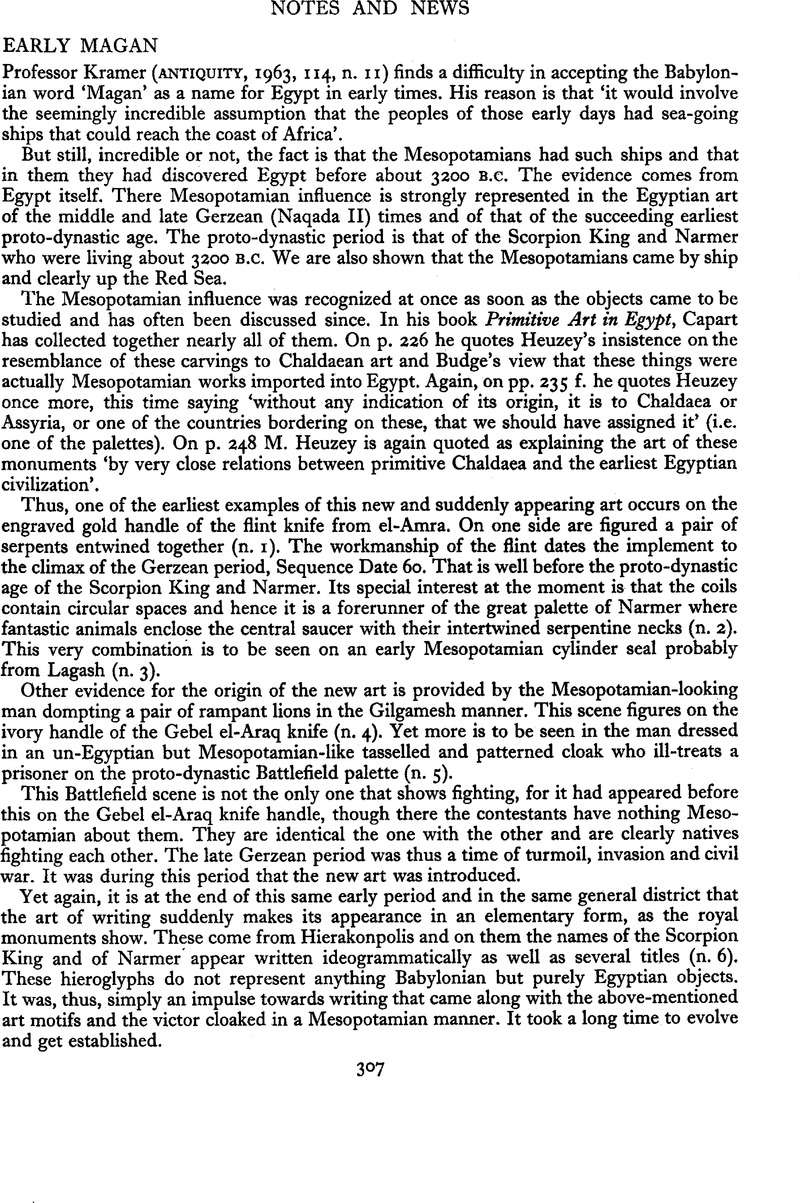No CrossRef data available.
Article contents
Abstract

- Type
- Notes and News
- Information
- Copyright
- Copyright © Antiquity Publications Ltd 1963
References
(1) Capart, fig. 33, p. 68. The design became a favourite in primitive Egypt for two more examplee are known, figs. 37, 38, pp. 72, 73. That on fig. 37 has begun to vary from the original, for the plain serpents have here become homed vipers.
(2) Capart, fig. 184, p. 245.
(2) Capart, fig. 184, p. 345.
(3) Wainwright, in Annates du service des antiquités de l’Égypte (Cairo), 27 (1927), pp. 98 ff.Google Scholar, and fig. 6, p. 99 and p. ico. Heuzey was the first to draw attention to the similarity in Comptes rendus de I’Acad, des inscr. et belles lettres, 1899, pp. 66–68 and pi. on p. 62. See Weigall, again in Anns. Serv., 11 (1911), pp. 170 f.Google Scholar
(4) Bénédite, in Journal of Egyptian Archaeology, 5 (1918), pi. xxxii facing p. 225.CrossRefGoogle Scholar
(5) Capart, fig. 179, p. 240.
(6) Capart, figs. 189, 184, 187. Arkell has recently published a new fragment of the Scorpion King in ANTIQUITY, (1963), 31–35, pis. iii, iv, and figs, i, 2.
(7) Benedite, loc. cit.
(8) Even if the knife came from Gebel et-Târif, as has been said, it would make no difference to the argument, for this place is just opposite el-Amra across the river. Unfortunately there is some confusion as to its place of origin. The most detailed account brings it from el-Amra. Other places besides Gebel et-Târif named are Abydos or its environs (Capart, p. 68, note 1). Abydos is only 8 miles north of el-Amra. Thus, wherever the knife came from, it would have come from the same district as the Gebel el-Araq knife.
(9) Petrie, , Naqada and Bailas, p. lxxvii and p. 59.Google Scholar
(10) Bénédite, in Journal of Egyptian Archaeology, 5 (1918), p. i and pi. xxxiv facing p. 234.CrossRefGoogle Scholar
(11) Wainwright, Man, 1947, 147 and n. 49.Google Scholar
(12) Engelbach, , Annales du service des antiquités de l’Égypte, 31 (1931), 135.Google Scholar
(13) Wainwright, loc. cit. The little bottles are dated by the verses which they bear, for they all come from poets who flourished in the 7th, 8th and 9th centuries. Sebakh is the old refuse used today as fertilizer on the fields. It is almost entirely of post-Pharaonic date.
(14) The one from Zuweidah was brought me by one of my workmen who was digging sebakh there. It is now in the Pitt Rivers Museum, Oxford.




